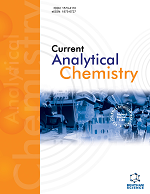- Home
- A-Z Publications
- Current Analytical Chemistry
- Previous Issues
- Volume 7, Issue 2, 2011
Current Analytical Chemistry - Volume 7, Issue 2, 2011
Volume 7, Issue 2, 2011
-
-
Characterization of Carbon Nanotubes Paste Electrode and its Application as Rutin Sensor
More LessAuthors: Aline C. Oliveira and Lucia H. MascaroCarbon nanotubes paste electrodes (CNTPE) were prepared using carbon nanotube and mineral oil at different compositions. The carbon nanotubes/mineral oil content in the paste electrode was evaluated using cyclic voltammetry which was 60% (w/w) carbon nanotube. This electrode was characterized by SEM and EIS. The SEM results showed that CNTS structure is not modified by maceration process. From EIS analysi Read More
-
-
-
Catalytic Conversion of Thermal Decomposition Products of Halogen Containing Polymers Studied by Pyrolysis-GC-MS
More LessAuthors: Marianne Blazso and Janos BoziFeedstock recycling of plastics wastes by pyrolysis is adequate for obtaining valuable oil. However, thermal decomposition products of the halogen containing components of the plastics are contaminating the pyrolysis oil. In this work, pyrolysis-gas chromatography-mass spectrometry combined with online catalytic conversion has been applied to study the activity of Na-zeolite catalysts for dehalogenation of chloro- and bromo-hy Read More
-
-
-
Analytical Methods for the Determination of Anti-diuretic Peptides in Biological Samples: Challenges and Perspectives
More LessAnti-diuretic peptides are widely used for the control of body water balance. With the growing concerns on their pharmacological characteristics and clinical safety, there is an increasing request of sensitive, selective and robust analytical assays for the determination of anti-diuretics in biological samples. This article provides a perspective review of various methodologies developed and validated in the past, including im Read More
-
-
-
Voltammetric Determination of Acyclovir in Human Urine Using Ultra Trace Graphite and Glassy Carbon Electrodes
More LessAuthors: Murat Sadikoglu, Gulsen Saglikoglu, Sultan Yagmur, Erdem Orta and Selehattin YilmazAn electroanalytical method was developed for the direct quantitative determination of Acyclovir (Acy) in spiked human urine base on its oxidation behavior. The electrochemical oxidation and determination of Acy were easily carried out on ultra trace graphite electrode (UTGE) and glassy carbon electrode (GCE) using a variety of voltammetric techniques. The electrochemical measurements were carried out on these elect Read More
-
-
-
Ag+-selective poly(vinyl chloride) Membrane Electrode Based on [N,N'- ethylenebis-(3-methoxy salicylaldimine)]
More LessA solid state silver selective poly (vinyl chloride) (PVC) membrane electrode was developed by using recently synthesized [N, N'-ethylenebis-(3-methoxy salicylaldimine)] as an active component of the membrane. The best sensitivity and selectivity for Ag+ ions were obtained for the electrode membrane containing ionophore-NPOE-PVC and KTpClTB in composition of 4:62:33:1 (w/w). The proposed electrode had a Ne Read More
-
-
-
Penicillium digitatum Loaded on Pumice Stone as a Solid Phase Extractor for Preconcentration of Co(II), Fe(III) and Ni(II)
More LessAuthors: Sitki Baytak and A. Rehber TurkerA solid phase preconcentration procedure is described by using Penicillium digitatum loaded on pumice stone for the determination of Co(II), Fe(III) and Ni(II) in water and vegetables samples by flame atomic absorption spectrometry (FAAS). Experimental variables, including pH, amount of solid-phase, eluent type and flow rate of sample solution were optimized for quantitative recovery of the analytes. The effect of interfering io Read More
-
-
-
Application of Immunological Techniques (from Vaccination to Final Measurements) in Determination of Pharmaceutical Residues in Environmental Samples
More LessAuthors: Blazej Kudlak and Jacek NamiesnikNumerous biologically active compounds are intuitively produced by humans and are present in the environment. Their fate and the occurrence of their metabolites still remain a great challenge for environmental analysts and risk assessors. There are a lot of different analytical approaches leading to the determination of residues of pharmaceuticals used both by humans and for veterinary purposes. However, the majority o Read More
-
Volumes & issues
-
Volume 21 (2025)
-
Volume 20 (2024)
-
Volume 19 (2023)
-
Volume 18 (2022)
-
Volume 17 (2021)
-
Volume 16 (2020)
-
Volume 15 (2019)
-
Volume 14 (2018)
-
Volume 13 (2017)
-
Volume 12 (2016)
-
Volume 11 (2015)
-
Volume 10 (2014)
-
Volume 9 (2013)
-
Volume 8 (2012)
-
Volume 7 (2011)
-
Volume 6 (2010)
-
Volume 5 (2009)
-
Volume 4 (2008)
-
Volume 3 (2007)
-
Volume 2 (2006)
-
Volume 1 (2005)
Most Read This Month
Article
content/journals/cac
Journal
10
5
false
en


